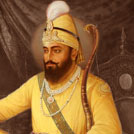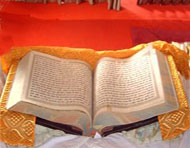 |
|||
|
|
|||
|
||||||
| One of the most joyful Punjabi festivals, Baisakhi commemorates one of the greatest religious incidents in Sikhism - the formation of the Khalsa order by the 10th Sikh spiritual leader, Guru Gobind Singh. Go through this article to know the fascinating history of Baisakhi. Know why Baisakhi is observed and why this occassion holds such importance for Sikhs all over the world. If you like reading about the "History of Baisakhi", click here and share this article with your loved ones. Celebrate Baisakhi with DeepestFeelings.com! |
| Baisakhi, also known as Vaisakhi or Vasakhi, is
one of the greatest Sikh festivals. Mainly observed in Punjab as a harvest
festival since ancient times, Baisakhi owes its name to "Baisakh", a month
in the solar Nanakshahi calendar of the Sikhs and marks the the beginning of
a new solar year, and new harvest season. But the most significant origin of the famous Baisakhi festival can be traced long back to a well-known incident in the history of the Sikh religion. It was the fag end of the 17th century, a time when the greater part of the Indian subcontinent was under Mughal domination. The attitude of the Mughal rulers were different as far as their tolerance for other religions was concerned. While the earlier Mughal monarchs like Akbar treated every religion equally and viewed each spiritual path as a different way to God, the later kings of this dynasty were of the view that Islam was the only true religion and that every inhabitant of India should follow it. The Mughal ruler Aurungzeb wanted to spread Islam in India. Naturally, when Guru Teg Bahadur, the ninth spiritual leader of the Sikhs, stood up for the rights of Hindus and Sikhs the monarch saw him as a threat and an obstacle in his grand religious scheme. He publicly beheaded Guru Teg Bahadur on November 11, 1675 to stop the latter's activities and also let this execution serve as a warning to the followers of other religions.  But the undying fire of righteousness leapt forth again when a new spiritual
leader was appointed by the Sikhs. Guru Gobind Singh became the tenth Sikh
leader. In the summer of the year 1699, he organised a huge celebration of
Baisakhi. Baisakhi, which was only an ancient harvest festival for the
people of the Punjab region till this time, assumed an altogether new
significance in the light of the incidents that took place at Anandpur in
1699. But the undying fire of righteousness leapt forth again when a new spiritual
leader was appointed by the Sikhs. Guru Gobind Singh became the tenth Sikh
leader. In the summer of the year 1699, he organised a huge celebration of
Baisakhi. Baisakhi, which was only an ancient harvest festival for the
people of the Punjab region till this time, assumed an altogether new
significance in the light of the incidents that took place at Anandpur in
1699.On March 30, 1699, Guru Gobind Singh called on a large congregation of Sikhs at Keshgarh Sahib near Anandpur. The purpose of the Guru was to instill courage and strength to sacrifice among his fellow men. He understood that nothing but an armed struggle was required to show the Mughals that the Sikhs were not ready to let their religion be maligned and subjugated. When thousands of people assembled for his blessings, Guru Gobind Singh came out of his tent carrying an unsheathed sword. He gave a powerful speech to infuse courage amongst fellowmen. He ended his speech with the demand for men who were ready to sacrifice themselves for greater good as every great deed required equally great sacrifice. But none was prepared to give himself up to the Guru. At the Guru's third call, a thirty-year-old man named Daya Ram Khatri responded and went ahead to become a volunteer. The Guru took the man inside a tent. After sometime he came back alone with a bloodied sword, much to the horror of everyone present there. He called again for a volunteer. Another man walked up to him. The same thing happened again and the Guru returned again to call for another man. This was repeated for three more times until a total of five Sikhs had gone into the tent with the Guru. The Guru took a long time to return after he went with the fifth man, during which everyone speculated that all the men were being killed for some sacred sacrificial ritual. It did not go down well with most present there despite the fact that the people had immense faith on their leader. So everyone heaved a sigh of relief when they found their Guru reappearing with the five men, each of them wearing turbans and clad in saffron-coloured garments. Besides Daya Ram Khatri, a shopkeeper by profession, there stood Dharm Das, a Jat (farmer) from Delhi; Mokhan Chand, a washerman from Dwarka; Sahib Chand a Nai (barber) from Bidar and Himmat Rai, a (Ghumar) water carrier from Jagannatha. The Guru named these five men "Panch Piara" or 'Beloved Five' and blessed them with an elaborate ritual. The men sat on a special dais made for the occasion while he prepared water to bless them. Mata Sundari Ji, the wife of the Guru, put a batasha (a type of sweet) into an iron vessel containing water. The Guru mixed this with the water using a sword called "Khanda Sahib", while the congregation recited sacred verses from scriptures to complete the ritual. The water thus prepared was considered the sacred nectar of immortality called amrit. The Guru gave it first to the five volunteers to drink, then he had some of it himself and later distributed the remaining part amongst the crowd. With this ceremony, everyone present there, irrespective of caste or creed, became members of the "Khalsa Panth" (the Order of the Pure Ones). The five men initiated as the "Panch Piaras" were regarded as the first members of the Khalsa and the embodiment of the Guru himself. He asked every Sikh male to use the surname of "Singh" (meaning "lion") and also took the name for himself. The women were instructed to call themselves "Kaur", assistants to the "Singh". He asked Sikhs to follow the five K's: Kesh (hair) - He asked them to wear their hair long. Kangha (comb) - He asked them to use a comb. Kripan (dagger) - He asked them to carry along a dagger all the time to protect themselves. Kachha (shorts) - He asked them to wear shorts. Kara (bracelet) - He instructed them to wear a bracelet.  He also did away with the tradition of Gurus and asked all Sikhs to accept
the "Grantha Sahib" as their eternal guide. He urged them to come to him
with their hair and beard unshorn to get baptized by the sword. He also did away with the tradition of Gurus and asked all Sikhs to accept
the "Grantha Sahib" as their eternal guide. He urged them to come to him
with their hair and beard unshorn to get baptized by the sword.This important ceremony was a landmark event in Sikh religious religious and social history. Firstly it rekindled the religious zeal and cultural pride for the Sikhs. Secondly, it infused the spirit of bravery and fearlessness among the Sikh youths who were to be the harbingers of change and the champions of religious and cultural freedom. Thirdly, the initiation of the five volunteers, who came from different castes and social strata, as well as the instruction of using similar surnames obliterated the caste differences in the contemporary society and formed a big step towards national integration. Since then, Baisakhi has been observed on the first day of the Baisakh month in the solar Nanakshahi calendar, which corresponds to April 14 in the Gregorian calendar. The formation of the "Khalsa Panth" is still marked across the country in gurdwaras where special prayer meetings are also organised where millions of Sikhs come together to pay a tribute to Guru Gobind Singh. Holy songs are sung and sacred verses are read aloud to commemorate the historic event of 1699 and pay a tribute to the Guru as well as his beloved five men. Food offerings are dedicated to the Guru which are afterwards distributed among members of the congregation. |
| Back
to Home | Nostalgia
| Flowers
| Kiss
| Love
| Graduation
| Birthday
| Business
| Thank
You | Husband-Wife
| New-Born
| Pets
| Friendship
| Nature
| Virtual
Food Good-Morning | Get-Well-Soon | Peace | Hello | Hi | Cartoons | Humor | Sorry! | Anniversary | Good Luck | Weekend | Hugs | Toys | Cricket Greeting Cards |